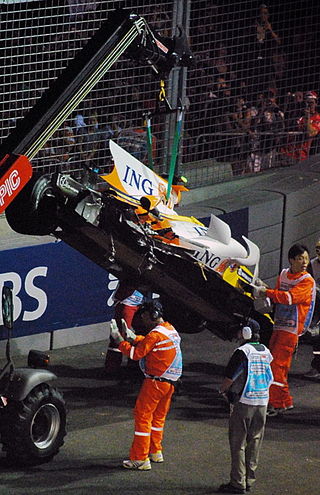
Simtek was an engineering consultancy firm and Formula One racing team. The Formula One (F1) engineering consultancy arm, Simtek Research, was founded in 1989 by Max Mosley and Nick Wirth. It originally was involved in many areas of Formula One, including wind tunnel construction and chassis building for third parties. Simtek Grand Prix, the racing team, was launched in 1993 and competed in the 1994 and 1995 seasons, achieving a best result of ninth place. With large debts and a lack of sponsorship money, Simtek went into voluntary liquidation in June 1995.

The 1995 FIA Formula One World Championship was the 49th season of FIA Formula One motor racing. It featured the 1995 Formula One World Championship for Drivers and the 1995 Formula One World Championship for Constructors, which were contested concurrently over a seventeen-race series that commenced on 26 March and ended on 12 November.

Patrick Bruce Reith Symonds is a British motor racing engineer. He was the Chief Technical Officer at Williams Grand Prix Engineering from 2013 until 2016, having previously worked at the Benetton, Renault and Virgin Formula One teams. He is currently the Chief Technical Officer of Formula One. In September 2009, Symonds was forced to resign from the ING Renault F1 team due to his involvement in race fixing at the 2008 Singapore Grand Prix. After the Fédération Internationale de l'Automobile (FIA) conducted its own investigation, Symonds and Renault's Managing Director Flavio Briatore were banned indefinitely from any events sanctioned by the FIA, although this ban was later overturned by a French Tribunal de Grande Instance.
Mecachrome SAS is a precision engineering company based in France that operates in the aerospace, motor racing, energy and defence sectors.

Robert Charles Bell is a former Formula One engineer and technical director, best known for his work with the Renault Formula One team.
Nikolas Tombazis is a racing car designer who has worked in Formula One since 1992 for the Benetton, McLaren, and Ferrari teams.

André de Cortanze is a French motorsport engineer.

The Simtek S951 was a Formula One car designed by Nick Wirth and Paul Crooks and used by Simtek for the 1995 season. The number 11 seat was taken by Domenico Schiattarella and the number 12 seat was taken by Jos Verstappen. The team's test driver was Hideki Noda. Noda was set to take the number 11 seat for the second half of the season, but the team folded after round five. The engine was a Ford-Cosworth EDB 3.0l V8. The team's main sponsor was MTV.
Prodrive F1 Team was the name of a proposed Formula One team to be run by Prodrive. The team was selected by the FIA in 2006 to be the 12th entry into the 2008 Formula One world championship. In November 2007, a legal challenge to the team's proposed use of customer cars led to Prodrive pulling out of the 2008 season.
Allegations of cheating were made throughout the 1994 Formula One World Championship. Several Formula One teams were involved, with the main allegations surrounding Benetton Formula. Initially, Benetton was alleged to have been using illegal traction control software to their advantage in races; however, this could not be sufficiently proven by the FIA and was only confirmed in 2015 when Willem Toet, one of Benetton's engineers that season, wrote an article on his Linkedin account describing how the team developed a traction control system using spark cutting. A refuelling fire on Jos Verstappen's Benetton car at the 1994 German Grand Prix led to renewed allegations and an investigation by Intertechnique at Benetton's team factory. Following the investigation, the FIA revealed Benetton had been using a fuel valve without a fuel filter, which allowed fuel into the car 12.5% faster than a legal fuel valve. Renewed allegations led to rumours of Schumacher quitting the team, Schumacher would end up staying with Benetton for the 1995 Formula One season, also winning the Drivers' World Championship that season, before joining Ferrari for the 1996 Formula One season where he would stay until the 2006 Formula One season, winning five additional Drivers' titles in the process.
Wirth Research is a group of engineering companies, founded by Nicholas Wirth in 2003, specialising in research, development, design and manufacture for the motor racing industry and other high technology sectors.

The Renault Formula One crash controversy, dubbed Crashgate by some in the media, was a sporting scandal caused when Renault F1 driver Nelson Piquet Jr. deliberately crashed during the 2008 Singapore Grand Prix to give a sporting advantage to his Renault teammate, Fernando Alonso.

The DAMS GD-01 was an unraced Formula One car used by the French motorsport team, Driot-Arnoux Motor Sport (DAMS). The GD-01 was designed and built by a collaboration of DAMS and Reynard engineers from 1994 to 1995, and was intended to establish the team—which had achieved considerable success in lower categories—in Formula One (F1), the premier Fédération Internationale de l'Automobile (FIA)-sanctioned level of racing. However, due to insufficient financial backing, the team never entered the championship, despite completing construction of the chassis and conducting limited testing.

Virgin Racing was a Formula One racing team which was under management of Manor Motorsport, Wirth Research and Richard Branson's Virgin Group and competed in 2010 with a British licence and in 2011 with a Russian licence. It scored no points and finished last in the Constructor's Championship for the two years the team competed.

The Virgin VR-01 was a Formula One motor racing car designed by Nick Wirth for Virgin Racing in the 2010 season. It was driven by former Toyota driver Timo Glock and Brazilian ex-GP2 driver Lucas di Grassi. The car was the first Formula One racing car designed entirely with computational fluid dynamics. The car was due to be launched online through the official team website on 3 February 2010, but technical issues prevented the live internet broadcast from taking place.

The Virgin MVR-02 is a Formula One racing car designed by Wirth Research for Marussia Virgin Racing, and used by them during the 2011 Formula One season. Like its predecessor, the Virgin VR-01, the MVR-02 was designed entirely with computational fluid dynamics, with Nick Wirth's design studio doubling their CFD capacity ahead of the 2011 season. The addition of the "M" in the car's chassis designation reflected the team's new owner, Russian sports car manufacturer Marussia Motors. The car was unveiled in London on 7 February 2011, and was driven during the racing season by returning driver Timo Glock and debutant Jérôme d'Ambrosio.

The Andrea Moda S921 was a Formula One car designed by Simtek and used by the Andrea Moda Formula team in the 1992 Formula One season. It was driven by the experienced Brazilian Roberto Moreno and Englishman Perry McCarthy.

The Marussia MR02 is a Formula One racing car designed under the leadership of Marussia's Technical Director Pat Symonds. It made its competitive debut in the 2013 Formula One season where it was driven by debutant drivers Max Chilton and Jules Bianchi, who replaced Luiz Razia, the team's original choice for the seat. The car was launched at the Circuito de Jerez on 5 February, making the MR02 the first car that Marussia has completed in time to start winter testing. As of the 2024 Formula One season, the Marussia MR02 is the last F1 car to be powered by an engine designed by Cosworth.
Manor Grand Prix Racing Limited, trading as Manor Racing MRT or Pertamina Manor Racing MRT, was a British Formula One racing team and constructor based in Banbury, Oxfordshire in the United Kingdom. The team competed from 2010 through 2016.
Nick Chester is a motorsport engineer.













